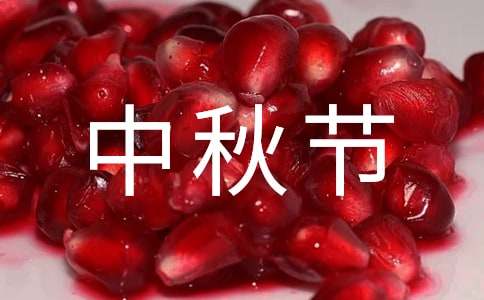英語中秋節的資料
今天就是一年一度的中秋節,在這個特殊的節日,如果你的周圍的老外朋友們問你中秋節的起源,傳說和習俗,你有自信給他們流利介紹嗎?

或許你的答案是:不能。那么今天英語演講君特別整理了三個英文(雙語)視頻,讓你自己完整了解我們中華民族的傳統節日中秋節,也希望你可以讓外國朋友們全面了解這個傳統節日。同時,英語演講君誠摯地祝大家中秋節快樂!
中秋節是什么?
What is Mid-Autumn Festival?
To the Chinese, Mid-Autumn Festival means family reunion and peace. The festival is celebrated when the moon is believed to be the biggest and fullest. To the Chinese, a full moon is a symbol of prosperity, happiness, and family reunion.
對中國人來說,中秋節意味著團聚、平安。人們覺得,中秋節的月亮最大、最圓。滿月象征著繁榮、幸福和團圓。
中國人怎么過中秋?
How the Chinese Celebrate Mid-Autumn?
Many traditional and meaningful celebrations are held in most households in China, and China's neighboring countries. The main traditions and celebrations include eating mooncakes, having dinner with family, gazing at and worshipping the moon, and lighting lanterns.
大部分中國家庭以及中國的'鄰國都會舉行許多傳統的慶祝活動,主要慶祝方式包括吃月餅,吃團圓飯,賞月和點燈籠。
中秋節起源版本一
Why Mid-Autumn Festival is Celebrated and How it Started?
Mid-Autumn Festival has a history of over 3,000 years, dating back to moon worship in the Shang Dynasty (1600–1046 BC). It’s such an important festival that many poems were written about it, stories and legends about the festival are widespread, and its origins have been guessed at and explained by generations of Chinese.
中秋節有三千多年歷史,可以追溯到商代時對月亮的崇拜。因為中秋節的重要地位,歷代詩人都會為中秋節寫詩,關于中秋節的故事、傳奇在民間廣為流傳,中秋節的起源也被歷代中國人探究。
The term "Mid-Autumn" first appeared in the book Rites of Zhou (周禮), written in the Warring States Period (475–221 BC). But the term only related to the time and season; the festival didn't exist at that point.
“中秋”一詞最早出現在戰國時期《周禮》一書中,但是該詞只和時間和季節有關,當時還沒有中秋節。
In the Tang Dynasty (618–907 AD), it was popular to appreciate the moon. Many poets liked to create poems related to the moon when appreciating it. There is a legend that Emperor Xuanzong of the Tang Dynasty visited the Moon Palace in his dream and heard a wonderful song.
唐代時賞月風靡,詩人在賞月之時佳作連連。據傳,唐玄宗曾在夢中去往月宮并聽到優美的歌聲。
In the Northern Song Dynasty (960–1127 AD), the 15th day of the 8th lunar month was established as the "Mid-Autumn Festival". From then on, sacrificing to the moon was very popular, and has become a custom ever since.
北宋時期,農歷八月十五才被正式確立為中秋節,從那以后,為月亮獻祭盛行,從那以后便成為風俗。
中秋節起源版本二
The Mid-Autumn Festival falls on the 15th day of the 8th lunar month, usually in early September to early October of the Gregorian calendar with full moon at night. It is a time for family members and loved ones to congregate and enjoy the full moon - an auspicious symbol of abundance,harmony and luck. Adults will usually indulge in fragrant mooncakes of many varieties with a good cup of piping hot Chinese tea, while the little ones run around with their brightly-lit lanterns.
每年農歷八月十五日,是傳統的中秋佳節。這時是一年秋季的中期,所以被稱為中秋。在這天,每個家庭都團聚在一起,一家人共同觀賞象征豐裕、和諧和幸運的圓月。此時,大人們吃著美味的月餅,品著熱騰騰的香茗,而孩子們則在一旁拉著兔子燈盡情玩耍。
The festival has a long history. In ancient China, emperors followed the rite of offering sacrifices to the sun in spring and to the moon in autumn. Historical books of the Zhou Dynasty had had the word "Mid-Autumn". Later aristocrats and literary figures helped expand the ceremony to common people. They enjoyed the full, bright moon on that day, worshipped it and expressed their thoughts and feelings under it. By the Tang Dynasty (618-907), the Mid-Autumn Festival had been fixed, which became even grander in the Song Dynasty (960-1279). In the Ming (1368-1644) and Qing (1644-1911) dynasties, it grew to be a major festival of China.
中秋節有悠久的歷史,和其它傳統節日一樣,也是慢慢發展形成的,古代帝王有春天祭日,秋天祭月的禮制,早在《周禮》一書中,已有“中秋”一詞的記載。后來貴族和文人學士也仿效起來,在中秋時節,對著天上又亮又圓一輪皓月,觀賞祭拜,寄托情懷,這種習俗就這樣傳到民間,形成一個傳統的活動,一直到了唐代,這種祭月的風俗更為人們重視,中秋節才成為固定的節日,《唐書·太宗記》記載有“八月十五中秋節”,這個節日盛行于宋朝,至明清時,已與元旦齊名,成為我國的主要節日之一。
The Mid-Autumn Festival probably began as a harvest festival. The festival was later given a mythological flavour with legends of Chang-E, the beautiful lady in the moon.
中秋節最早可能是一個慶祝豐收的節日。后來,月宮里美麗的仙女嫦娥的神話故事賦予了它神話色彩。
中秋節還有哪些習俗呢?
賞月
admire the full moon /
watch the full moon to celebrate the festival
碧空如洗,圓月如盤。人們在盡情賞月之際,會情不自禁地想念遠游在外、客居異鄉的親人。中國人歷來把家人團圓、親友團聚,共享天倫之樂看得極其珍貴,歷來有“花好月圓人團聚”之謂。
點燈籠
light lanterns
中秋之夜,天清如水,月明如鏡,可謂良辰之美景,然而對此人們并未滿足,于是便有燃燈以助月色的風俗。
玩花燈
play with lanterns / scaldfish
中秋玩花燈主要只是在家庭、兒童之間進行的,多集中在南方。
祭月
offering sacrifice to the moon
中秋祭月儀式是一種古老的祭祀禮儀,表達人們祈求月神降福人間的一種美好心愿。
【英語中秋節的資料】相關文章:
中秋節英語手抄報資料08-01
關于中秋節的英語手抄報資料08-05
關于中秋節英語手抄報的資料08-05
小升初英語資料10-17
考研英語的聽力資料05-17
關于元旦的英語資料01-10
中秋節的手抄報資料08-03
中秋節的意義 中秋節手抄報資料08-07
有關元旦的資料英語09-27
中秋節的手抄報圖片資料08-31